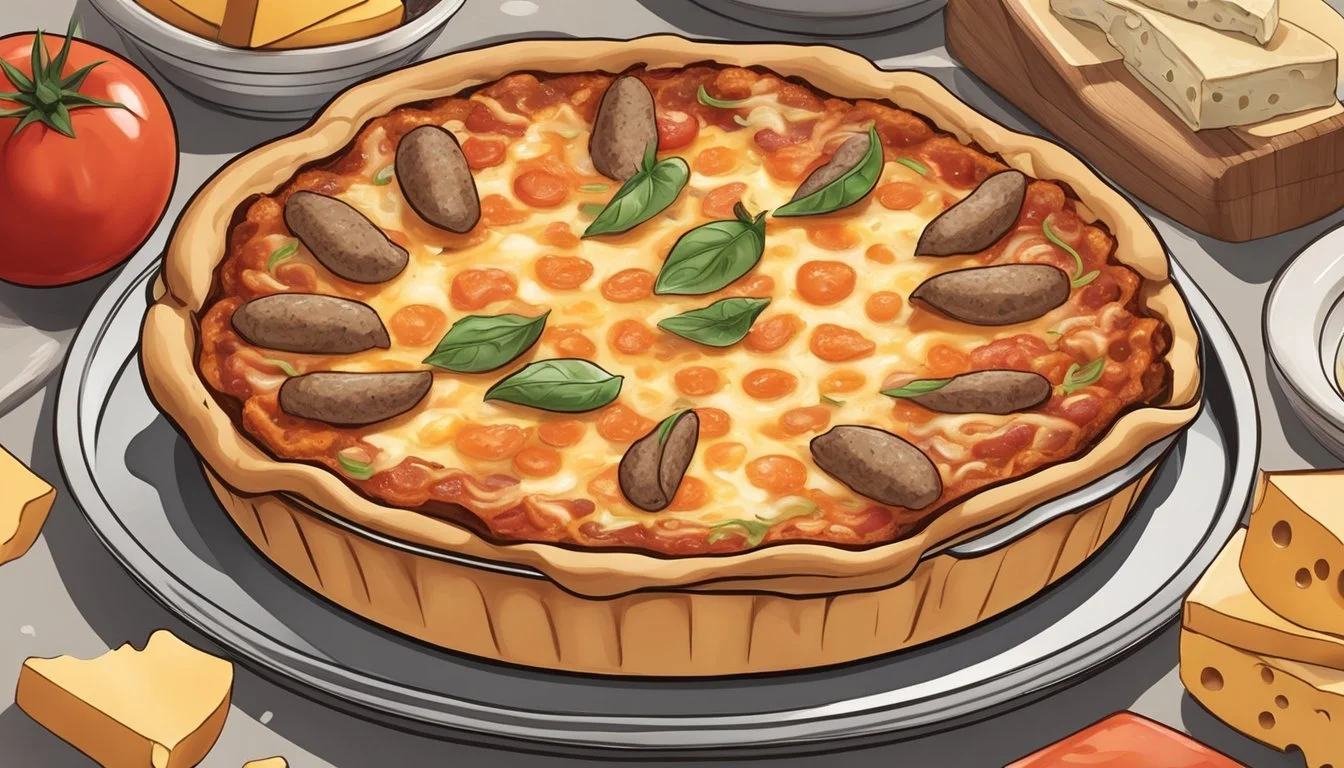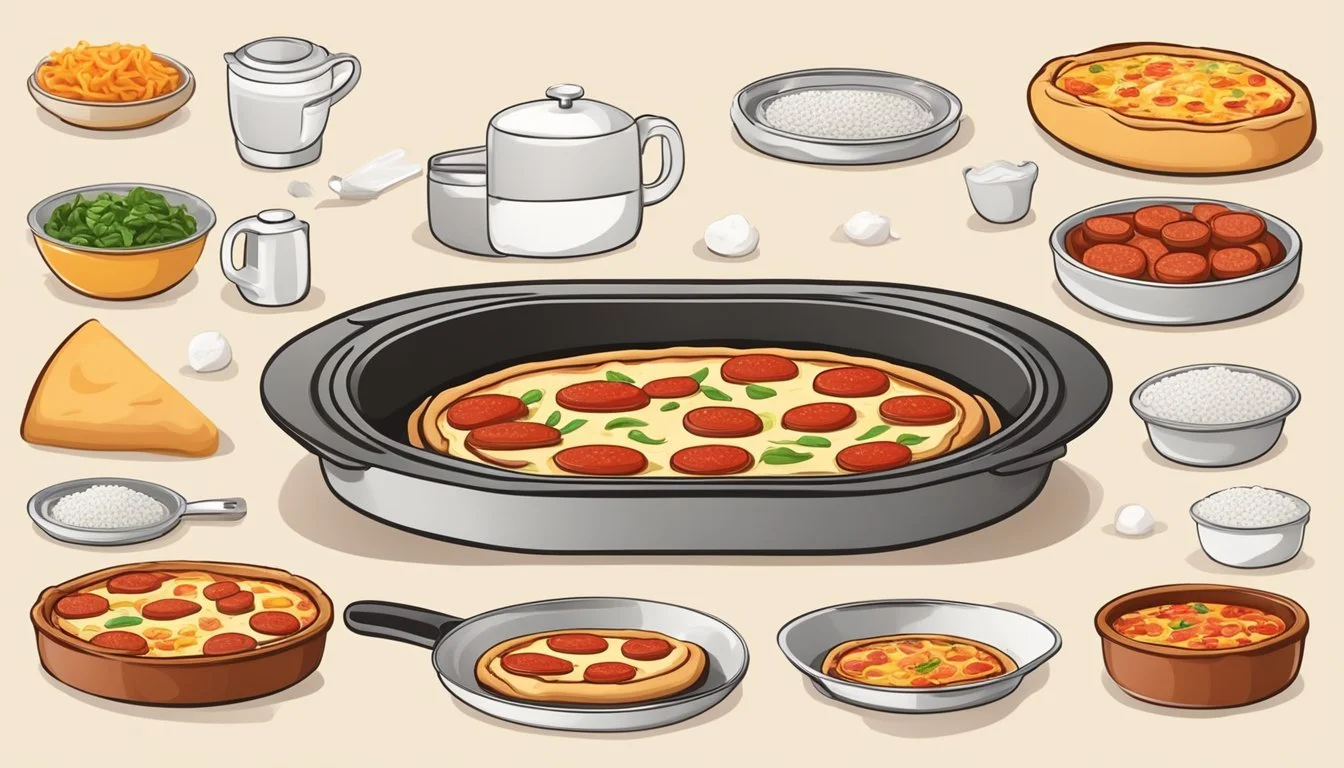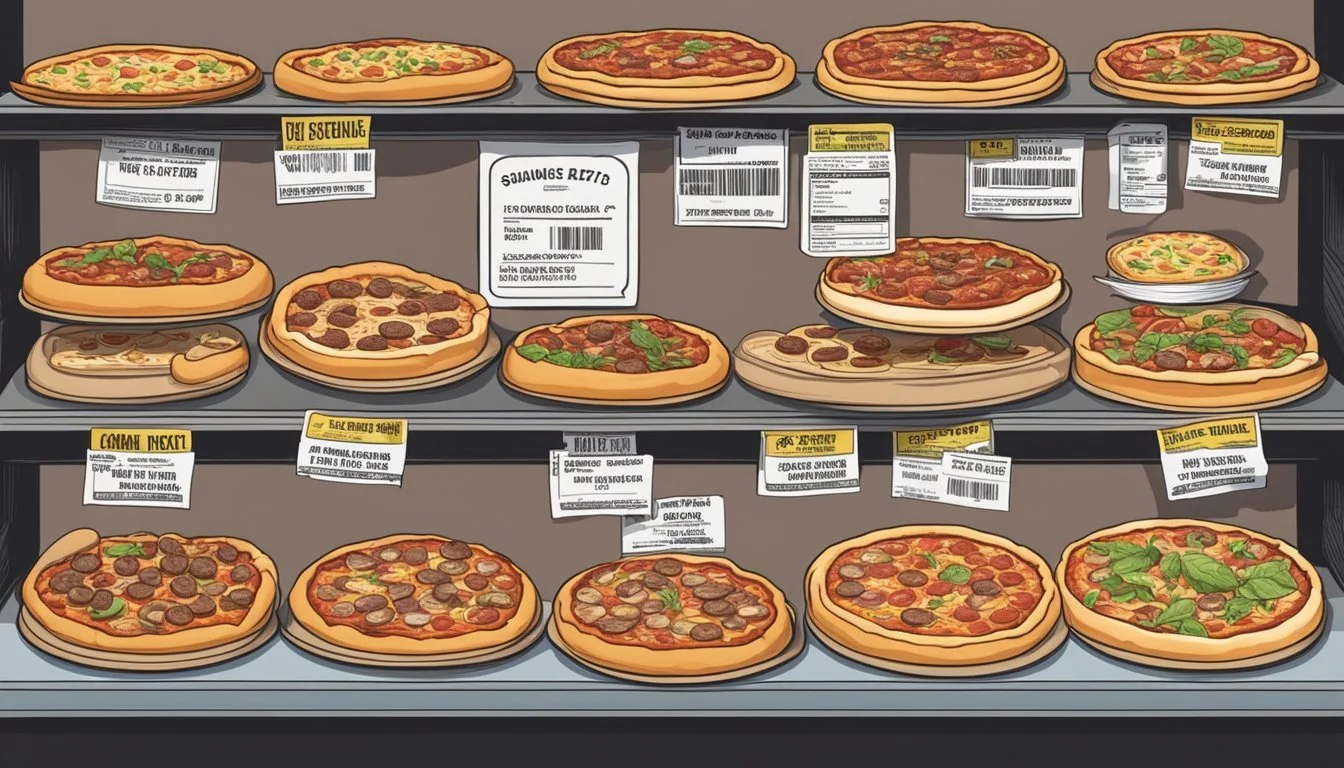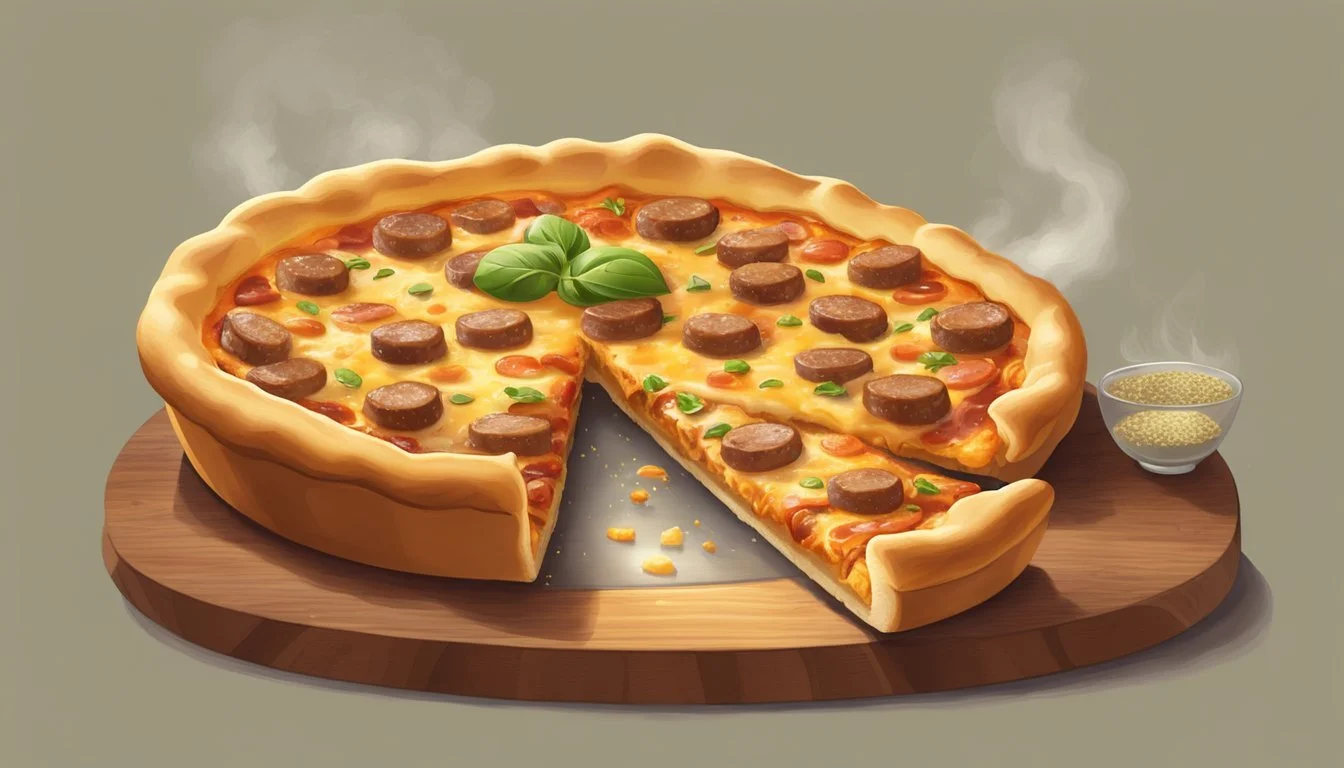How Long Does Deep Dish Sausage Pizza Last?
Essential Storage Tips
Deep-dish sausage pizza, a beloved staple of Chicago-style cuisine, is known for its thick, buttery crust and generous layers of sausage, cheese, and chunky tomato sauce. This hearty dish can be savored fresh out of the oven or enjoyed as leftovers, given the proper storage. Properly stored in the refrigerator, deep-dish sausage pizza can last for 3 to 4 days.
The deliciously dense crust and rich toppings of a deep-dish sausage pizza also make it suitable for freezing. When wrapped tightly in plastic wrap and aluminum foil or stored in an airtight container, it can last up to 2 months in the freezer. To enjoy it at its best, always reheat thoroughly.
Understanding how to store and preserve this flavorful pizza not only extends its enjoyment but also ensures food safety. Whether it’s a homemade Chicago-style deep dish or a slice from your favorite pizzeria, knowing the shelf life of your deep-dish sausage pizza is key to savoring every bite without worry.
Essentials of Deep-Dish Sausage Pizza
Deep-Dish Sausage Pizza stands out for its rich ingredients and distinctive preparation. Mastering this Chicago-style delicacy involves understanding its elements and how they come together.
Defining Deep-Dish Pizza
Deep-Dish Pizza, often referred to as Chicago-style pizza, is characterized by a thick crust that forms a deep, buttery base. Unlike regular pizza, the crust rises high, creating a bowl-like shape to encase the generous fillings.
One key difference is the layering method. The order usually starts with cheese, followed by sausage or other meats, then vegetables, and finally topped with tomato sauce. This layering helps protect the crust from becoming soggy.
Another hallmark is the pan used. Typically, a 12-inch cast iron skillet or deep-dish pizza pan is coated with softened butter, which aids in achieving a crispy, golden crust. The baking temperature is generally around 425°F for optimal results.
Key Ingredients
The components of a Deep-Dish Sausage Pizza are crucial for its unique flavor and texture. Key ingredients include:
Dough: Made with flour, cornmeal, salt, yeast, sugar, and water. Cornmeal is essential for the traditional coarse texture.
Cheese: Primarily mozzarella, often laid directly on the dough to prevent the crust from becoming soggy.
Sausage: Typically Italian sausage, either pre-cooked or raw, distributed in chunks or crumbled.
Tomato Sauce: A robust, slightly chunky sauce made from crushed tomatoes, seasoned with garlic, basil, and oregano.
Vegetables (optional): Common additions are green peppers, onions, and mushrooms.
Crust: The bottom and sides are often layered with shredded parmesan for additional flavor and a crispy finish.
These ingredients work in harmony, resulting in a satisfying and hearty meal.
Preparation and Cooking Instructions
Creating a delicious deep-dish sausage pizza involves making a well-risen dough, assembling the ingredients properly, and baking it to perfection. Each step ensures a tasty and satisfying result.
Dough Preparation
To make the dough, combine 3 ¼ cups of all-purpose flour, 1 ½ cups of warm water, 2 ¼ teaspoons of active dry yeast, 1 teaspoon of sugar, ½ cup of cornmeal, and 1 teaspoon of salt. Start by dissolving the active dry yeast and sugar in warm water. Let the mixture sit for 5 minutes until it turns frothy.
In a large mixing bowl, add the flour and salt. Gradually incorporate the yeast mixture into the flour, mixing until a soft dough forms. Turn the dough onto a floured surface and knead it for 8-10 minutes until it's smooth and elastic. Place the dough in a greased bowl, cover it, and let it rise in a warm place for about an hour, or until it has doubled in size.
Assembling the Pizza
Preheat your oven to 425°F (220°C). Grease a 10-inch cake pan or cast-iron skillet with olive oil. Roll out the dough to fit the pan, ensuring it covers the bottom and the sides.
Begin layering with freshly sliced mozzarella cheese. Next, evenly spread Italian sausage, thinly sliced green peppers, and onions over the cheese layer. Adding a few slices of pepperoni for extra flavor can be a bonus. Sprinkle a mixture of parmesan cheese and Italian seasoning on top to enhance the taste.
Baking Guidelines
Place the assembled pizza into the preheated oven. Bake for 30-35 minutes until the crust turns golden brown and the cheese bubbles. Use a fork to check that the crust is cooked through to avoid any doughy spots.
For a crispy crust, brush the edges with a bit more olive oil before baking. After removing from the oven, let the pizza cool for a few minutes before cutting it into slices. This resting period allows the cheese to set, making it easier to serve.
Proper Storage Techniques
To maximize the freshness and safety of deep dish sausage pizza, it is crucial to use effective storage methods. This ensures the pizza remains delicious and safe to eat for an extended period.
Refrigeration
Refrigerating deep dish sausage pizza can extend its shelf life by several days. After allowing the pizza to cool to room temperature, it should be tightly wrapped in plastic wrap or aluminum foil. Alternatively, the slices can be stored in an airtight container.
The United States Department of Agriculture (USDA) recommends keeping leftovers like pizza in the refrigerator for no more than 3-4 days. Ensure the refrigerator maintains a consistent temperature of 40°F (4°C) or below.
Keeping the pizza on an oven rack in the fridge allows for better air circulation, which helps maintain the crust's texture. However, using this technique might require additional coverage to prevent odor absorption.
Freezing
For longer storage, freezing deep dish sausage pizza is an excellent option. Wrap individual slices tightly in plastic wrap, followed by a layer of aluminum foil to prevent freezer burn. Placing the wrapped slices in a freezer-safe bag or airtight container provides extra protection.
When ready to eat, thaw the pizza in the refrigerator overnight. Reheat it in an oven at 375°F (190°C) for 10-15 minutes until it's hot and the cheese is melted. This method retains most of the original texture and flavor.
Freezing can keep pizza safe to eat for up to 2-3 months. Always label the storage containers with the date to track how long the pizza has been frozen. Proper freezing techniques ensure that the deep dish sausage pizza remains a convenient and tasty meal option.
Shelf Life and Food Safety
Deep-dish sausage pizza has specific storage requirements to ensure it remains safe to eat. Understanding refrigerated and frozen pizza storage and knowing the signs of spoilage are essential.
Refrigerated Pizza Lifespan
When stored in the refrigerator, deep-dish sausage pizza can remain safe to consume for 3 to 4 days. It is crucial never to leave the pizza at room temperature for more than 2 hours, as this increases the risk of bacterial growth.
To maximize freshness, wrap the pizza tightly in either aluminum foil or place it in an airtight container. Use proper reheating methods to ensure it's heated to a safe temperature before eating.
Frozen Pizza Lifespan
For longer storage, freezing deep-dish sausage pizza can extend its shelf life to 2 to 3 months. Ensure that the pizza is wrapped in freezer-safe materials like freezer wrap, aluminum foil, or placed in a heavy-duty freezer bag or airtight container.
Label the package with the date to keep track of storage time. Thaw the pizza in the refrigerator before reheating to maintain quality and safety.
Signs of Spoilage
There are several signs that deep-dish sausage pizza may have spoiled. Visual indicators such as mold or discoloration on the cheese, crust, or sausage are clear warnings.
Off smells, including sour or rotten odors, suggest bacterial growth. Also, any changes in texture, such as a slimy or sticky feel, indicate spoilage. If any of these signs are present, it’s best to discard the pizza to avoid the risk of foodborne illness.
Tips for Best Taste and Quality
Deep-dish sausage pizza can maintain its deliciousness if you follow proper reheating methods and pay attention to preserving its flavor and texture. Proper care is crucial to ensure every bite remains as delightful as the first.
Reheating Instructions
Reheating deep-dish sausage pizza involves specific steps to bring back its fresh-baked quality. The oven is the best choice to achieve a crispy crust and even warming. Preheat the oven to 375°F (190°C). Place the pizza on a baking sheet lined with parchment paper or foil for about 15-20 minutes.
For a quicker option, a skillet on medium heat with a lid for 5-8 minutes can also work, ensuring the cheese melts evenly and the bottom remains crispy. Avoid microwaving as it can lead to a soggy crust and uneven heating, compromising the overall texture.
Maintenance of Flavor and Texture
To maintain flavor and texture, proper storage is necessary. Wrap the pizza tightly in aluminum foil, or use an airtight container before refrigerating. This prevents the crust from drying out and keeps the cheese and sauce fresh.
When freezing, separate individual slices with parchment paper to avoid them sticking together. Use within 1-2 months for the best flavor. Always allow the pizza to cool before wrapping, as placing hot pizza in a container can create condensation, leading to a soggy crust.
By following these tips, the deep-dish pizza retains its delicious taste and enjoyable texture, making it just as satisfying as when it was freshly baked.
Additional Considerations
When making a deep dish sausage pizza, there are a few key aspects to consider for a customized experience and complementary pairings to enhance the meal.
Customizing Your Pizza
Customizing a deep dish sausage pizza allows for creative latitude. Toppings such as mushrooms, green peppers, and spinach add nutritious value and delightful flavors.
It's recommended to incorporate a pizza sauce that sits on top, often chunky tomato sauce, for authentic taste. Try blending dried oregano, dried basil, and Italian seasoning into the sauce for a robust flavor.
For those who prefer heat, sprinkling red pepper flakes or additional seasoning can elevate the spiciness. Experimenting with different cheeses like mozzarella and parmesan ensures an enjoyable cheesy crust.
Pairings and Side Dishes
Pairing the deep dish sausage pizza with complementary side dishes enhances the dining experience. Salads with fresh ingredients such as arugula, cherry tomatoes, and a simple vinaigrette are excellent accompaniments, providing a light counterbalance to the rich pizza.
Traditional side dishes include garlic bread or breadsticks seasoned with dried oregano and Italian seasoning. Additionally, offering a side of marinara or pizza sauce for dipping can be a hit.
For beverages, consider serving with red wine or craft beer to complement the flavors of the pizza and toppings. This combination ensures a full, satisfying meal for any pizza occasion.







